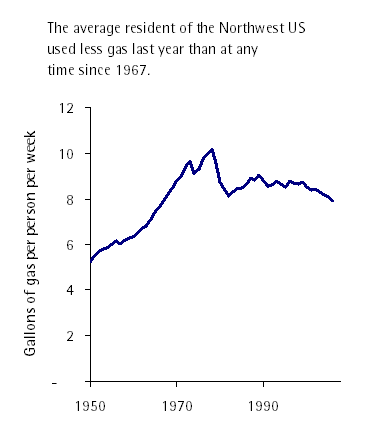(Listen to the KUOW story on gasoline trends.)
One of the most striking findings from this year’s Cascadia Scorecard (just released today, by the way) is that northwesterners are using less gasoline. In fact, per person gas consumption on the Northwest’s roads and highways has fallen by nearly a tenth since the late 1990s.
To put the recent declines in context: cutting gas consumption by nearly a tenth is equivalent to each driver taking a one-month holiday from driving each year.
At this point, the average resident of the US Northwest uses less gas than at any time since 1967.
Of course, the region’s population has increased, so the trend in total consumption isn’t quite as rosy: rather than declining, total consumption has remained roughly flat for the last 8 years or so. But even that represents a huge break from the preceding decade and a half, during which gas consumption rose roughly in tandem with population.
Apparently, sharp price increases since the late 1990s—when gas prices, adjusted for inflation, were at all time lows—has prompted a number of changes in how we get around town:
-
We’re driving a bit less. Person for person, vehicle mileage trends in the Northwest are on the decline. The decline is small, and tentative—but if federal numbers are to be believed, it’s real. Possible reasons: rising gas prices have encouraged us to chain trips (e.g., to run two errands on one trip) and to choose destinations closer to home (e.g., the local hardware store rather than the megastore a few miles away). A gradual increase in urban density in recent years may have contributed to the decline in driving; people tend to drive less in urban areas, since there’s a greater variety of stores and services a short drive away, or even within easy walking or biking distance.
-
We’re driving more efficient cars. In the Northwest, sales of hybrids have outpaced Hummers for years. More generally, there’s some evidence that sales of the largest, least efficient SUVs have fallen. But more subtle shifts are likely having an impact. In families that have access to more than one vehicle, people are choosing to use more efficient ones for some trips.That is, some people who have the option are choosing cars over trucks.
-
We’re riding transit. Between 1999 and 2006, transit boardings in greater Vancouver and Portland have gone up by about 25 percent; in the Puget Sound it’s been about 11 percent. Commuters, in particular, seem to be choosing buses over cars—which may have as much to do with congestion and parking prices as with anything else.
So, gasoline is the good news. And it’s especially good, since the reductions, at least in the Northwest states, are steeper than for the rest of the US. The reasons for the Northwest’s advantages aren’t completely clear, but it may be that good transit and effective land use policies have given drivers in the Northwest more options for fuel savings than elsewhere in the country.
The bad news is that the broader energy trends tracked by the Scorecard aren’t doing so well. Diesel consumption is still on the rise, largely due to an increase in long-distance shipping. (We’re buying more stuff, and it’s coming from farther away.) And electricity consumption in homes and businesses apparently ticked upward last year—the third straight year of per capita increases.
The increases in diesel and electricity completely negated the decreases in gasoline consumption. So that gives us a good news/bad news story: good news in gasoline, and disappointing news for overall energy consumption.








